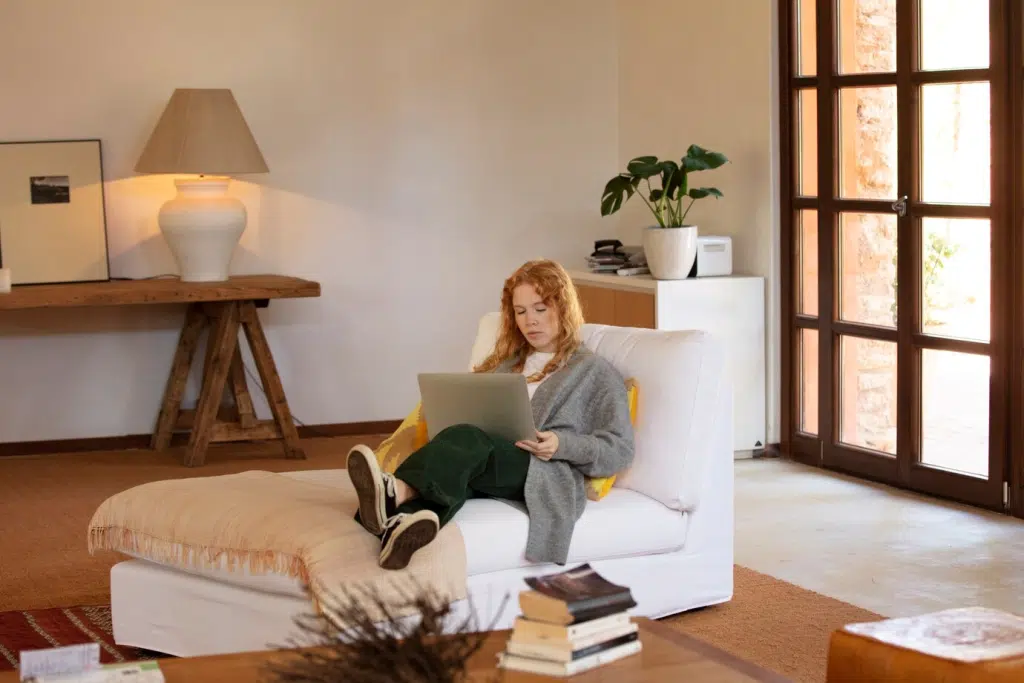Simplifying Your Home Space Can Boost Productivity
Oliver Reed August 4, 2025
Introduction
In 2025, with hybrid work and digital demands shaping our daily lives, a cluttered home can silently sabotage your productivity. Simplifying your home space can boost productivity by creating an environment that supports focus, reduces stress, and streamlines tasks. A tidy, intentional space isn’t just about aesthetics—it’s a practical way to enhance mental clarity and efficiency. Whether you’re working from home, managing personal projects, or balancing family life, a simplified home can transform how you approach your day. Here’s why simplifying your home space matters and how to do it effectively.

Why a Simplified Home Space Matters
A cluttered home overwhelms your brain with visual noise, making it harder to concentrate or feel in control. Simplifying your space—by decluttering, organizing, and prioritizing function—creates a calm, efficient environment that supports productivity. This is especially relevant in 2025, as flexible work arrangements and small living spaces demand smarter ways to manage our surroundings.
- Improved Focus: A clean space minimizes distractions, helping you stay on task.
- Reduced Stress: An organized home lowers anxiety, freeing mental energy for productive work.
- Time Savings: Simplified spaces make it easier to find what you need, cutting wasted time.
How Simplifying Your Home Space Boosts Productivity
1. Eliminates Distractions for Better Focus
A cluttered space competes for your attention, pulling your focus away from important tasks. Simplifying your home by removing unnecessary items creates a clear visual field, allowing your brain to concentrate on what matters.
- Why It Works: A streamlined environment reduces cognitive overload, making it easier to enter a flow state.
- Example: A desk with only your laptop, a notebook, and a pen keeps you focused on work, not stray papers or gadgets.
2. Reduces Decision Fatigue
Clutter forces you to make constant micro-decisions—where to put things, what to keep, or how to navigate mess. A simplified home minimizes these choices, preserving mental energy for meaningful tasks.
- Why It Works: Fewer items mean fewer decisions, leaving you with more bandwidth for problem-solving or creative work.
- Pro Tip: Keep surfaces clear by assigning a place for every item and sticking to it.
3. Streamlines Daily Routines
An organized home makes daily tasks—like cooking, working, or getting ready—more efficient. When everything has a designated spot, you spend less time searching and more time doing.
- Why It Works: Simplified systems reduce friction in your workflow, boosting productivity.
- Example: A kitchen with neatly organized utensils and ingredients speeds up meal prep, leaving time for other priorities.
4. Creates a Calming Environment
A tidy home fosters a sense of calm, reducing stress and creating a space where you can think clearly. This is critical for productivity, as stress can derail focus and motivation.
- Why It Works: A simplified space signals order and control, helping you feel ready to tackle tasks.
- Pro Tip: Use neutral colors or minimal decor to enhance the calming effect.
Practical Steps to Simplify Your Home Space
Simplifying your home doesn’t require a complete overhaul. Small, intentional changes can create a productive environment. Here’s how to get started:
1. Start with High-Impact Areas
Focus on spaces you use most, like your workspace, kitchen, or bedroom. Decluttering these areas first will have the biggest impact on your daily productivity.
- How to Do It: Spend 15 minutes sorting one area into three piles: keep, donate, or discard.
- Pro Tip: Tackle one drawer or shelf at a time to avoid feeling overwhelmed.
2. Adopt a Minimalist Mindset
Embrace the idea that less is more. Keep only items that serve a purpose or bring joy, and let go of things that add clutter without value.
- How to Do It: Ask yourself, “Do I use this regularly, or does it serve a specific purpose?” If not, consider letting it go.
- Example: Donate clothes you haven’t worn in a year or kitchen gadgets that collect dust.
3. Implement Smart Storage
Use storage solutions to keep your space organized and clutter-free. Clear bins, drawer dividers, or wall-mounted shelves can maximize space and keep items accessible.
- How to Do It: Choose storage that fits your space, like under-bed boxes for small apartments or labeled containers for kitchen supplies.
- Pro Tip: Opt for multi-functional furniture, like a coffee table with hidden storage, to save space.
4. Create Daily Maintenance Habits
Prevent clutter from creeping back by spending 5–10 minutes daily tidying key areas. This keeps your home functional and supportive of productivity.
- How to Do It: Before bed, reset one area, like clearing your desk or washing dishes.
- Example: Put away papers or devices after work to start the next day fresh.
5. Go Digital to Reduce Physical Clutter
Paperwork and physical items like bills or notes can quickly pile up. Digitizing documents and using cloud storage can keep your space clear and organized.
- How to Do It: Scan important papers and store them in apps like Google Drive or Evernote.
- Pro Tip: Set up automatic bill payments to reduce paper clutter and save time.
Maintaining a Simplified Home for Lasting Productivity
Once your home is simplified, maintaining it ensures long-term benefits. Here are tips to keep your space productive:
- Weekly Check-Ins: Spend 20 minutes each week reviewing high-use areas and addressing new clutter.
- One In, One Out Rule: For every new item you bring home, remove an old one to maintain balance.
- Involve Household Members: Encourage family or roommates to adopt similar habits for a cohesive environment.
- Reassess Seasonally: Every few months, evaluate whether your space still supports your productivity and adjust as needed.
Overcoming Common Simplification Challenges
- Challenge: Feeling sentimental about items.
Solution: Take photos of meaningful items before donating to preserve memories without clutter. - Challenge: Limited time for decluttering.
Solution: Start with 5-minute sessions in high-impact areas, like your desk or kitchen counter. - Challenge: Clutter returning over time.
Solution: Stick to daily tidy habits and the “one in, one out” rule to maintain order.
Tools to Support a Simplified Home
- Storage Solutions: Use clear bins, drawer organizers, or wall shelves for efficient organization.
- Digital Tools: Apps like Evernote or Todoist for managing digital documents and tasks.
- Cleaning Supplies: Keep a small caddy with essentials like wipes or a duster for quick tidy-ups.
- Planners: A simple notebook or app like Notion to track decluttering goals and habits.
The Bigger Picture: Productivity in 2025
In 2025, as remote work and flexible schedules remain common, a simplified home is a foundation for success. With digital distractions and hybrid lifestyles, a clutter-free space acts as a sanctuary for focus and efficiency. Simplifying your home space can boost productivity by creating an environment that supports your goals, reduces stress, and saves time. It’s a small investment with big returns for your work and personal life.
Conclusion: Simplify for Success
Simplifying your home space can boost productivity by clearing distractions, streamlining routines, and fostering a calm environment. Start with one high-impact area, adopt minimalist habits, and maintain your space with daily rituals. By creating a home that supports focus and efficiency, you’ll unlock more time and energy for what matters most. In a busy world, a simplified space is your key to working smarter and thriving.
References
McMains, S., & Kastner, S. (2011). Interactions of top-down and bottom-up mechanisms in human visual cortex. Journal of Neuroscience. https://www.jneurosci.org/content/31/2/587
Roster, C. A., et al. (2016). The dark side of home: Clutter and psychological well-being. Journal of Environmental Psychology. https://www.sciencedirect.com/science/article/abs/pii/S0272494416300659
Vohs, K. D., et al. (2013). Physical order produces healthy choices, generosity, and conventionality, whereas disorder produces creativity. Psychological Science. https://journals.sagepub.com/doi/10.1177/0956797613480186
Saxbe, D. E., & Repetti, R. (2010). No place like home: Home tours correlate with daily patterns of mood and cortisol. Personality and Social Psychology Bulletin. https://journals.sagepub.com/doi/10.1177/0146167209352864







